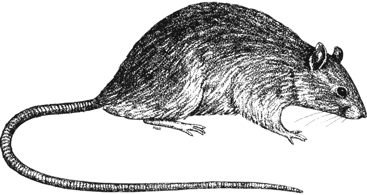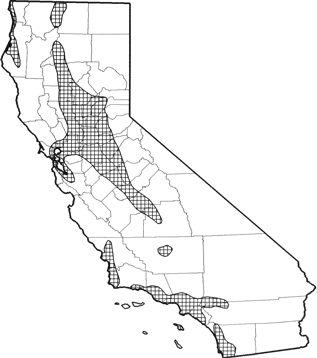
Black Rat
Distribution, Abundance, and Seasonality
The black rat was introduced to North America in the 1800's. Its distribution in California is poorly known, but it probably occurs in most urban areas. There are 2 subspecies present in California, R. r. rattus and R. r. alexandrinus. R. r. rattus, commonly called the black rat, lives in seaports and adjacent towns. It is frequently found along streamcourses away from buildings (Ingles 1947). R. r. alexandrinus, more commonly known as the roof rat, lives along the coast, in the interior valleys and in the lower parts of the Sierra Nevada. The distribution of both subspecies in rural areas is patchy. Occurs throughout the Central Valley and west to the San Francisco Bay area, coastal southern California, in Bakersfield (Kern Co.), and in the North Coast area from the vicinity of Eureka to the Oregon border. Confirmed locality information is lacking. Found in buildings, preferring attics, rafters, walls, and enclosed spaces (Godin 1977), and along streamcourses (Ingles 1965). Common in urban habitats. May occur in valley foothill riparian habitat at lower elevations. In northern California, occurs in dense himalayaberry thickets (Dutson 1973).

Range Map
Specific Habitat Requirements
Feeding: Omnivorous, eating fruits, grains, small terrestrial vertebrates, fish, invertebrates, and human garbage.
Cover: Prefers buildings and nearby stream courses. Where the black rat occurs with the Norway rat, it usually is forced to occupy the upper parts of buildings (Godin 1977).
Reproduction: No data found.
Water: Water is required, although a diet of garbage may satisfy the water requirements.
Pattern: Human habitation, preferably with open dumps. Dense vegetation may provide suitable habitat away from human habitation (Dutson 1973).
Species Life History
Activity Patterns: Nocturnal, though occasionally diurnal. Active yearlong.
Seasonal Movements / Migration: None.
Home Range: No data found. Densities in northern California thickets of himalayaberry reach 1 rat/16.4 m? (176 ft?) (Dutson 1973).
Territory: Territorial and highly social. Colonies formed from several family units probably share a territory and its resources. Apparently gregarious in himalayaberry thickets in northern California (Dutson 1973).
Reproduction: Breeds year-round, peaking in spring. Polygamous. Gestation period is 21-22 days. Litter size averages 6 altricial young. Weaning occurs at 3 wk. Sexual maturity is at 80-85 days (Godin 1977). Polyestrous.
Niche: The black rat is an omnivorous medium-bodied rodent. The Norway rat seems to be its closest competitor, followed next by the muskrat and other cricetid rodents. Predators include hawks, owls, weasels, skunks, dogs, foxes, snakes, Norway rats, and humans. Parasites include ticks, fleas, cestodes, trematodes, and nematodes (Godin 1977). It is more arboreal than the Norway rat. Carries such diseases as bubonic plague, typhus, salmonella food poisoning, rabies, tularemia, and trichinosis (Walker 1975).
Sources & References
California Department of Fish and Game, 1999.
California's Wildlife, Sacramento, CA.
Written by: P. Brylski, reviewed by: H. Shellhammer, edited by: R. Duke
Dutson, V. J. 1973. Use of the himalayan blackberry, Rubus discolor, by the roof rat, Rattus rattus, in California. Calif. Vector Views 20:59-68. Godin, A. J. 1977. Wild mammals of New England. Johns Hopkins Univ. Press, Baltimore, MD. 304pp. Ingles, L. G. 1947. Mammals of California. Stanford Univ. Press, Stanford, Calif. 258pp. Ingles, L. G. 1965. Mammals of the Pacific states. Stanford Univ. Press, Stanford, CA. 506pp. Marcot, B. G., ed. 1979. California wildlife/habitat relationships program: North Coast/Cascade Zone. Vol. III. Mammal narratives. U.S. Dep. Agric., For Serv., Six River Natl. For., Eureka, Calif. 261pp. Walker, E. P. 1975. Mammals of the world. Third ed. 2 Vols. Johns Hopkins Univ. Press, Baltimore, MD. 1500pp.
California Animal Facts | California's Wildlife